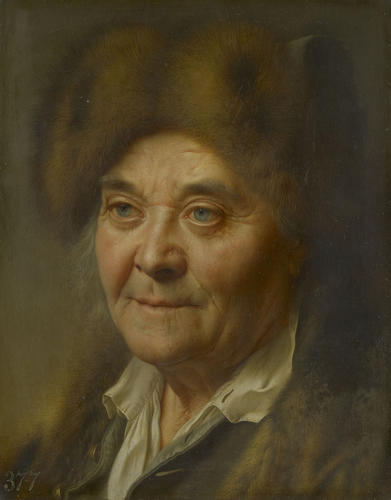An old Man's Head (Age) c.1730s
Oil on copper | 41.0 x 31.5 cm (support, canvas/panel/stretcher external) | RCIN 405619
-
Both the attribution (and provenance) of this painting and its companion, a Young Man’s Head (RCIN 405618), have remained elusive until 2011, when Lilian Ruhe proposed they were by Christian Seybold, a close contemporary of Balthasar Denner (1685-1749). After about 1728, Seybold emulated his style, high finish, astounding detail and accuracy. The paintings were first certainly recorded in Windsor in 1792, given to Denner. In 1824 they were recorded by William Hazlitt as by Denner with the more poetic titles of Youth and Age, although the author was critical of the style and realism, describing the pair as ‘in as perfectly bad a taste and style of execution as anything we ever say of this artist, who was an adept in that way.’ By 1854 they had moved to Hampton Court and Gustav Waagen in his Treasures of Art in Great Britain doubted the attribution to Denner, believing that the portraits appeared ‘rather to proceed from the hand of Seiboldt, his [Denner’s] ‘dry and spiritless imitator’. This attribution being levelled more as a term of denigration than connoisseurship. (Ruhe 2011, personal communication; Ruhe 2018, PhD Dissertation).
Despite his feminine features, the male model is the same as that in the character head in the Gemäldegalerie Alte Meister, Dresden (No. 2094, before 1747); the sitters sharing the same pale, watery eyes and lined forehead. The softer light source in the Royal Collection painting captures a reticence and slightly sorrowful expression in the sitter’s face, which is coupled with a demonstration of Seybold’s technical ability in bringing fur and other materials to life. Fur has long been associated with old age and the ‘winter of life’ and it is easy to see how the portrait might symbolise old age. Although the young boy, too, wears a fur-trimmed hat, suggesting that the two were not intended as pendants, although they have been read as such, certainly since the 19th century.
Born in Neuenhain, near Mainz, Seybold first appears in Vienna in 1715, where, from the early thirties, he would become an associate to the Academy of Arts and work for the imperial court. In 1745 he was appointed court painter at the Saxon-Polish court in Dresden and in 1749 imperial court painter in Vienna, both by decree. His earliest datable work is a portrait of Graf Johann Adam Questenberg (1678-1752) (Graz, Austria), which is also known through an engraving from 1728. He was influenced by Balthasar Denner, similarly producing intimate character heads, usually painted on copper, with a meticulous finish, and a neutral background. The numerous self-portraits and ‘tronies’ (character studies) in half or bust-lengths in the Dutch style, suggest that Rembrandt also remained a pervasive influence on the artist. (Ruhe 2018, PhD Dissertation).The painting appears in Pyne's illustrated 'Royal Residences' of 1819, hanging in the King's Closet at Windsor Castle (RCIN 922104).
Provenance
First recorded in the Queen's Closet at Windsor Castle in 1792 (Denner, 'old Man's head') together with a 'young Man's head' (RCIN 405618)
-
Creator(s)
(nationality) -
Medium and techniques
Oil on copper
Measurements
41.0 x 31.5 cm (support, canvas/panel/stretcher external)
56.8 x 48.2 x 4.0 cm (frame, external)
Alternative title(s)
Age, previously entitled








